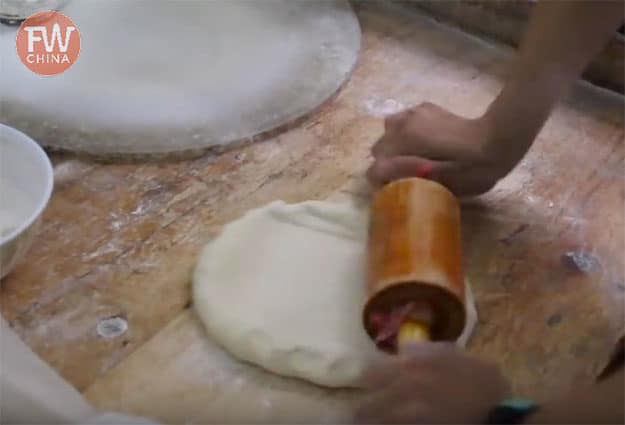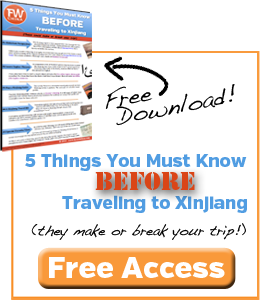How to Make Uyghur Bread from Xinjiang
For those who have traveled through Xinjiang, I don’t have to tell you just how delicious Uyghur bread is. It’s called “naan” or 囊 (náng) in Chinese and when you get it fresh from the oven, it just melts in your mouth! If you’ve ever been curious about how to make Uyghur bread from Xinjiang, join me as I bring you behind the scenes at a hole-in-the-wall bakery in Turpan.

For years I have walked by countless bread stands in Xinjiang, bought the Uyghur flatbread, and continued on my merry way. I’ve always been a bit curious about how to make Uyghur bread but never had the time to really watch the process.
Now before you get too excited, I must warn you that he didn’t share with me his exact Uyghur bread recipe (it’s a family secret) so this isn’t a true “how to” explanation. I apologize if you feel misled.
Still, I think you’ll enjoy this behind-the-scenes look at how Uyghur bread is made. It’s an integral part of the unique Uyghur culture and if you’ve eaten Uyghur bread you know that it’s certainly special.
[Video] How to Make Uyghur Bread
A gentle warning: don’t watch this “How to make Uyghur bread” video while hungry. :)
Don’t miss more awesome videos! Subscribe to FarWestChina on YouTube.
Looks delicious, doesn’t it? There’s a reason that this is one of the must-try foods from the Xinjiang region. And trust me when I say that Uyghur bread is best when eaten right out of the oven.
The Uyghur Bread-Making Process
The life of a Uyghur baker starts at 3:30am local time (5:30am Beijing time – learn more about Xinjiang time) when they start their morning run of bread. This is the hardest part of the day, which usually lasts for a little over 6 hours, ending at 10am local time.

If the bread lasts throughout the day, they’re done. If there’s need for more bread, however, they’ll begin again at 5pm local time for a smaller afternoon batch.
These Uyghur men work hard and I can tell you from hanging around for an hour that it’s not comfortable standing next to a hot oven in the heat summer, which in the Silk Road oasis of Turpan is sometimes unbearable!!
Step 1: Mix Ingredients and Knead the Bread Dough
The truth is that there are numerous kinds of Uyghur bread – flatbread with onion, flatbread with sesame, a bagel-like bread, plain disc-like bread, etc. Every bread maker has his own recipe and process, which is why some people will line up for a long time to purchase the bread from a popular stall.
Today, we’re talking about my friend’s well-known sesame flatbread.

The base ingredients for almost all flat breads in Central Asia (not just Uyghur bread) are the following:
- Flour: Most bakeries use a typical bleached white flour;
- Water: This is used both in the mixture as well as during the cooking;
- Salt: The amount of salt varies;
- Oil: China has so many different kinds of oil and the type of oil used for Uyghur bread varies based on the region and what’s cheaply available;
- Sugar: This ingredient isn’t always used, but many recipes call for at least a little sugar.
Again, there are many different Uyghur bread recipes, some which call for onions, sesame, or even nuts. Each bread stall is unique, which is why it’s important to try the local bread everywhere you go!
Step 2: Roll and Stamp the Bread Dough
After the kneaded dough sets for a little while, one of the Uyghur men begins to roll out the dough, creating what looks like a pizza crust.

The stretching of the dough is done by hand as well as with a traditional rolling pin that you see above.
One of the big differences is that he takes a special tool with pointed ends to “stamp” a pattern in the dough. Not only is this decorative, it helps the bread to cook through well.

Step 3: Season the Uyghur Bread Dough
At this point the dough is usually passed through a window to the bread maker outside who then dips it into whatever seasoning they choose.

In this case, the wet seasoning mixture was sesame, but as I’ve mentioned earlier, it could also be onions, nuts or something else entirely.
At this point the bread is ready to put in the oven, which has already been pre-heated.
Step 4: Bake the Bread in the Tannur
Almost all Uyghur bread is cooking in what is known as a “tannur”. This is an oven common all over Central Asia that is used to cook everything from bread to an entire lamb. The bread is placed on the side walls of the tannur where it sticks while cooking.

Throughout the baking process, the baker might change the position of the bread within the tannur, but there is no “flipping” or basting while the bread is in the oven.
That’s it! The outside bread maker uses a special padded tool to put the bread in the oven and then two long irons to take it out.

Final Thoughts | Food and the Uyghur Culture
One taste of Uyghur bread and you’ll understand why so many people love it. In addition to Uyghur bread, it’s also worth trying Uyghur lamb kebabs, the delicious Uyghur laghman and many other tasty local dishes. These foods are an integral part of the Uyghur culture here in Xinjiang and almost always part of big meals or celebrations.
When you’re in Xinjiang, take a moment to sit and watch a Uyghur bread maker at work. Take in the sweet aroma and eat the fresh bread.

It’s a fun cultural experience you won’t soon forget.
You can learn even more about Uyghur culture and where to travel around Xinjiang, you can find loads of valuable information in the FarWestChina Xinjiang travel guide.










